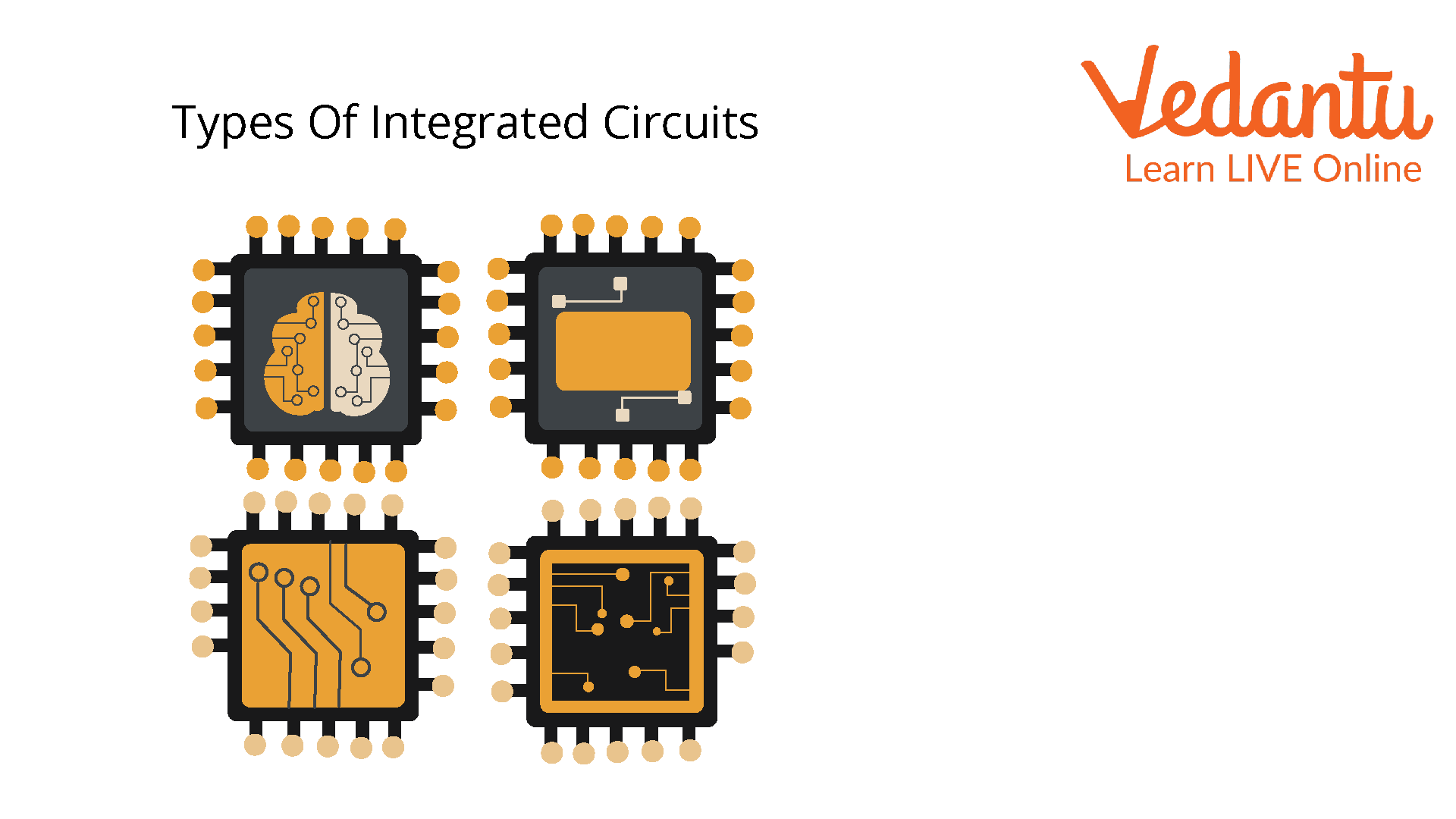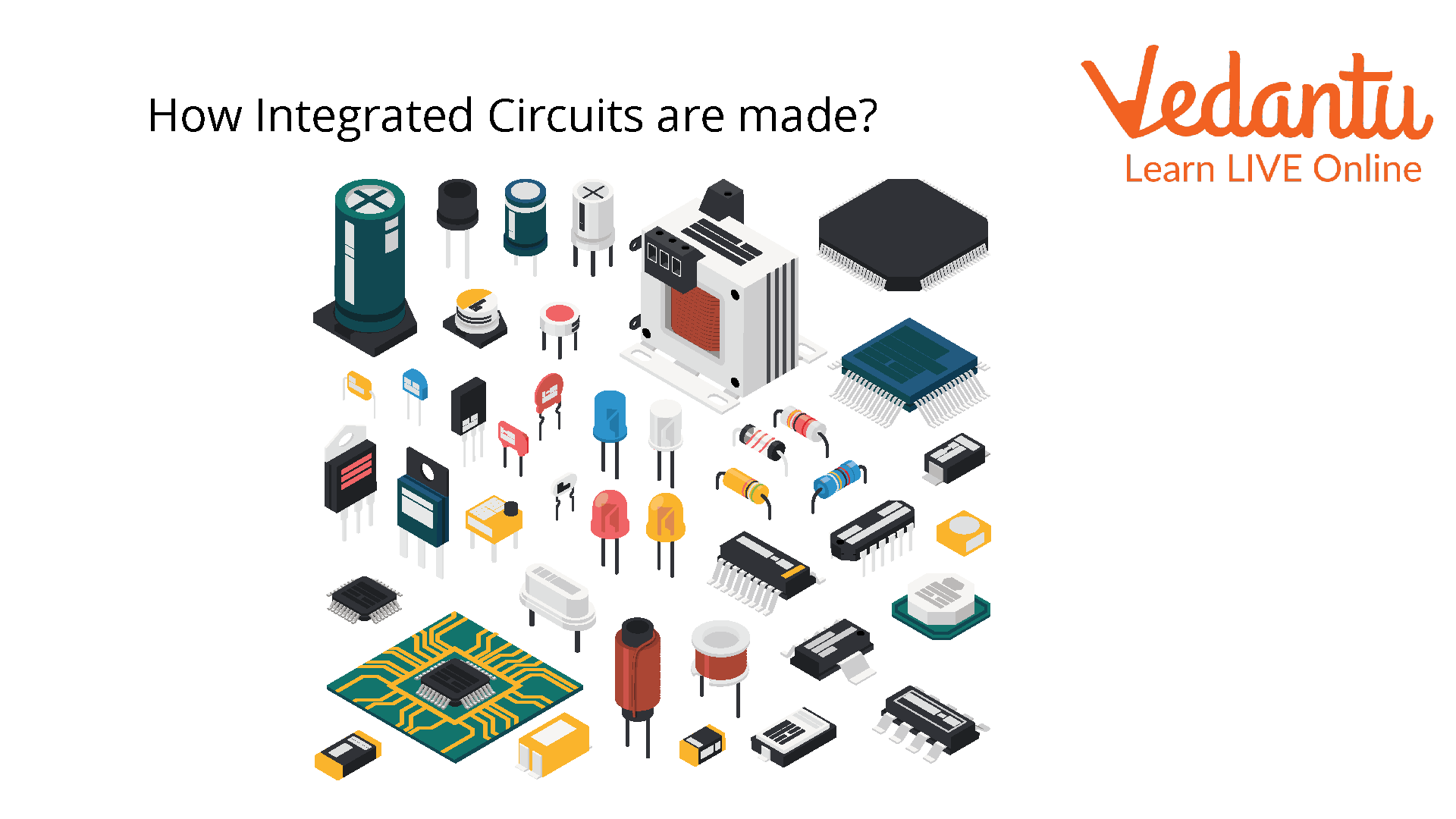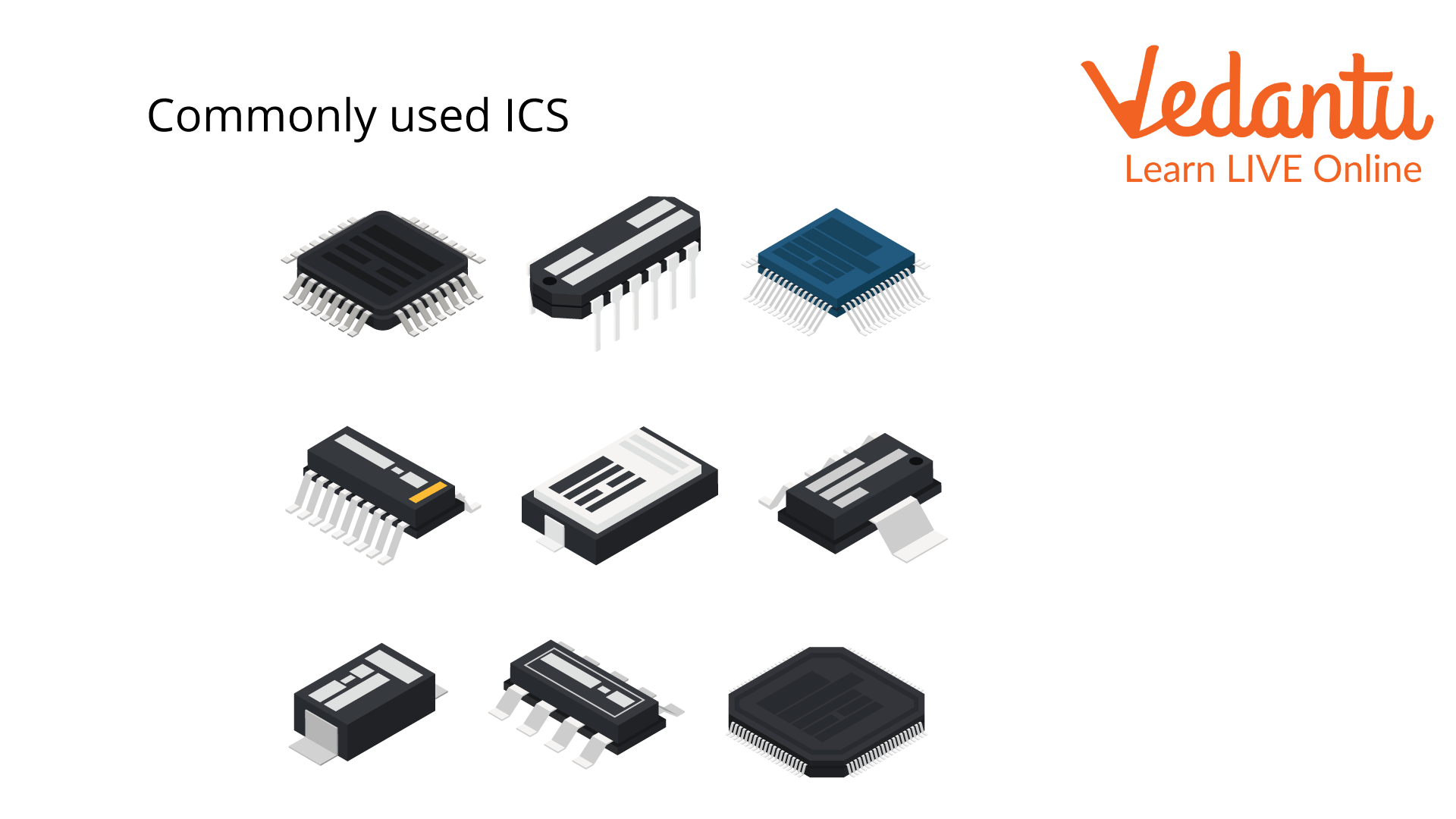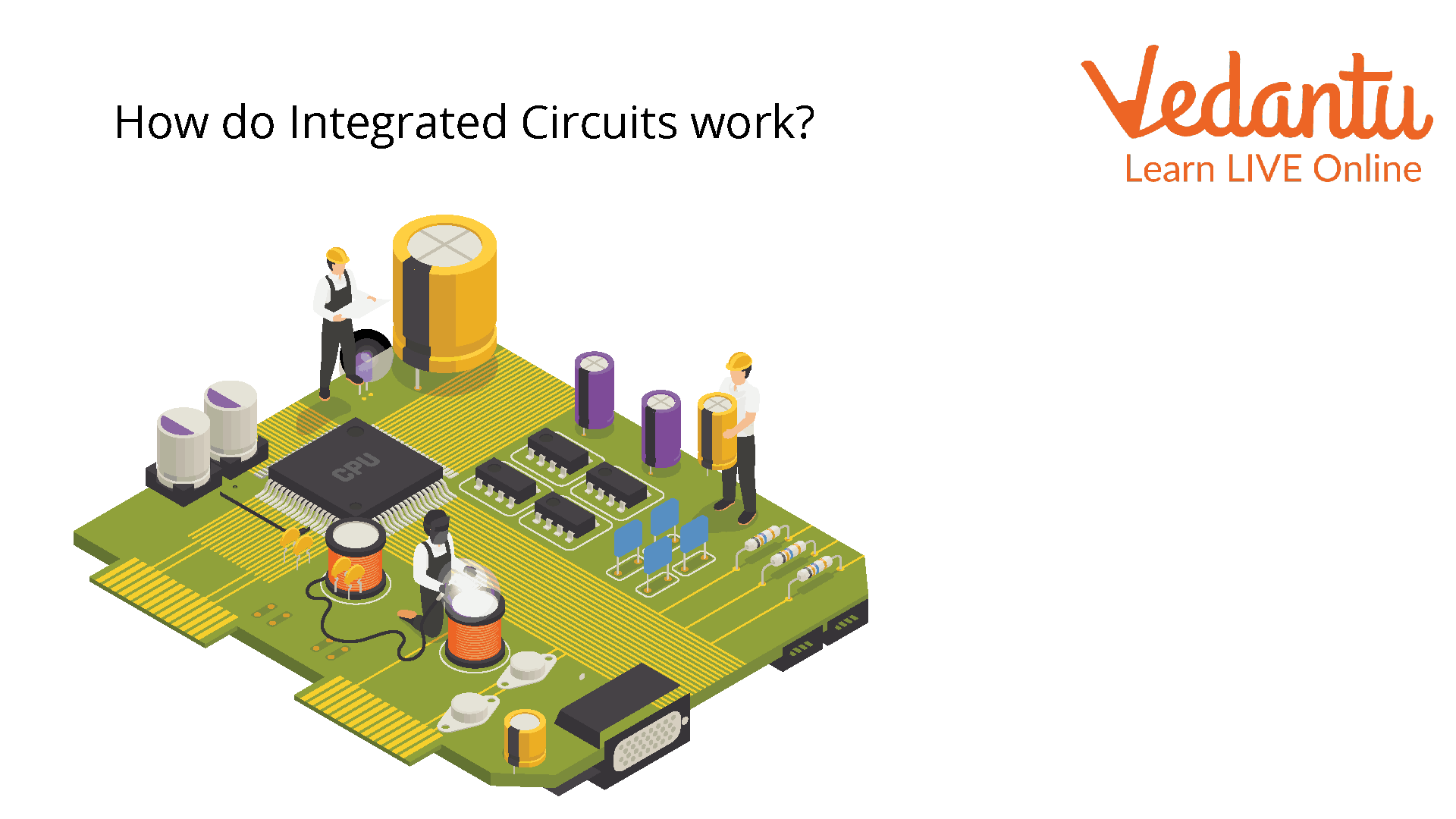




Introduction
Integrated circuits (ICs) are one of the essential parts of today's electronics. Most circuits can only work with them. They are the tiny black "chips" on almost every circuit board. Every electronic project you make will include at least one IC; thus, it's necessary to understand them.
An IC is a group of electronic parts, like resistors, transistors, capacitors, and so on, that are all packed into a small chip and linked together to do the same thing.
What are Integrated Circuits and their Types
1958: Invention of the Integrated Circuit

Defining the Types of Integrated Circuits
Solid-state devices were the first step in the history of integrated circuits. John Ambrose (J.A.) Fleming made the first vacuum tube, called a diode, in 1897. He came up with the left-hand rule for motors. In 1906, a new vacuum called a Triode was made.
Then, in 1947, Bell Labs came up with the transistor to replace vacuum tubes. This was partly because transistors are tiny and use less power to work. Different circuits, called "non-integrated circuits," were made by putting discrete components in various places on printed circuit boards and controlling them by hand. These ICs use a lot of power and space, and their output isn't as smooth as it could be.
In 1959, Integrated Circuits were made, which were made by putting several electronic and electrical parts on a single silicon wafer. Integrated circuits use little power to run and give out a smooth signal.
An integrated circuit (IC) is a tiny wafer, generally made of silicon, containing anywhere from thousands to billions of transistors, capacitors, and resistors. All these small electronics can use analogue or digital technology to do arithmetic and store information.
The following are the types of integrated circuits:
IC can be either linear (analogue) or otherwise digital, or a mix of the two, based on their use.
Analog or linear ICs have outputs that change continuously based on the level of the input signal. In concept, applications of integrated circuits could be in any variety of states.
Linear ICs are applied to boost the power of audio frequencies (AF) and radio frequencies (RF). The operational amplifier (op-amp) is often used-Campese situations. A temperature controller is another popular way an analogue IC is used. one can set up linear ICs to turn on or off different devices when a signal achieves a specific value. Such things are:
Air conditioners
Electric heaters
Ovens
Digital ICs only work over several signal strengths like analogue ICs. Instead, they only work at a few well-defined levels or areas of work. Digital ICs are made up of logic gates that also operate with binary data or signals, which can only be in different states: "low" (logic 0) and "high" (logic 1).
Mixed ICs - In mixed ICs, the ideas of analogue and digital are used. The mixed ICs change from analogue to digital or digital. Integration technology has come a long way, which has made it possible to put multiple analogue, RF, and digital functions on one chip.
How are Integrated Circuits Made?

Procedure for Making Integrated Circuits
The material that makes up an integrated circuit (IC) is silicon. A wafer is a flat piece of silicon on which the circuit is printed. Fabrication is the process of making ICs.
Commonly Used ICs

Commonly Used ICs
ICs That are Used Often:
ICs for Logic Gates
The array circuit makes logical outputs depending on the different signals. It might have only two or three inputs and only one outcome.
Timer ICS
A Timer IC is made with 100% or 50% switching frequency and allotted cycles.
Operation Amplifiers
Operational amplifiers, or OpAmps, are voltage amplifiers with a high voltage gain, a differential input, and a single-ended output.
Voltage Modulators
A voltage regulator IC keeps the DC power the same, even if the DC input shifts.
What Does an Integrated Circuit Do?

Defining the Meaning of "Integrated Circuit."
Before integrated circuits (ICs) were invented, the most common way to make an integrated the circuit computer was to choose parts like diodes, transistors, resistors, inductive loads, and capacitors and solder them together. Due to power and size problems, making a tiny circuit that used less power, was reliable, and could handle shocks was essential. In the history of integrated circuits, when semiconductors and transistors were invented, they made things easier in some ways.
Still, when integrated circuits were made, they changed how electronics work. Jack Kilby made integrated circuits from Texas Instruments and Bob Noyce from Intel, and they did it independently.
Integrated circuits are composed of various parts, such as diodes, computer chips, and R, C, and L. They are constructed on an integrated circuit, a tiny block or chip made of semiconductors (IC). They all work next to finish a specific task. Since the IC is easy to break, it is frequently put in a plastic case with metal pins tied to the circuit board.
Applications of Integrated Circuits
Integrated circuits' vast uses make it hard to imagine contemporary life without them. ICs are used in most electronics.
Nintendo, PlayStation, Xbox, and other digital platforms launched power-processor-based HD video games.
ICs function automatically and precisely in industries and robotics.
Drones utilise IC to fly and relay information through radio signals.
IC is used in mobile phones, satellites, radio, television, world wide web modems, switches, and other communications equipment to share data, audio, and video.
Microwave ovens or air conditioners employ ICs to regulate and maintain temperature sensors.
Smart cars like Tesla employ ICs to monitor pilots' heartbeats, follow GPS directions, and detect impediments from a distance.
Fun Facts about ICs for Kids
An integrated circuit is a piece of silicon prepared specially and then has a very complicated electronic circuit etched into it using photography.
Computer processors, memory, and other devices can all be put on silicon chips.
The chip is fragile, so it is usually wrapped in a tough plastic package. Metal legs that stick out of the package make electrical contact with the chip.
ICs are better than discrete circuits in two ways: they are cheaper and work better.
The price is low because photolithography prints millions of transistors as a single unit instead of building them one at a time.
The performance is better because the parts switch quickly and use less power.
Summary
Integrated circuit (IC), also named microcircuit, microchip, and the chip is a nanoscale way of making circuits manufactured on the edge of semiconductor wafers to make different circuit component frameworks. It is a set of electrical circuit designs on one tiny flat semiconductor material. There are many additional silicon chips in the industry, and there is not yet an application worldwide for naming integrated circuit configurations. So each company that makes integrated circuits has its way of referring to them.
FAQs on Integrated Circuits (History, Types and Uses)
1. What is an Integrated Circuit (IC) and what are its primary functions?
An Integrated Circuit (IC), also known as a microchip, is a miniaturised electronic circuit consisting of thousands or millions of transistors, resistors, and capacitors fabricated on a single, tiny piece of semiconductor material, typically silicon. Its primary functions include amplification, oscillation, timing, data processing, and memory storage, making it the fundamental building block of virtually all modern electronic devices.
2. Who were the key inventors credited with the creation of the integrated circuit?
The invention of the integrated circuit is credited to two engineers who developed the concept independently around the same time in 1958-1959. Jack Kilby of Texas Instruments created the first working prototype, while Robert Noyce of Fairchild Semiconductor developed an improved version using a silicon-based manufacturing process that made mass production feasible.
3. What are the main types of integrated circuits?
Integrated circuits are primarily classified based on their function and level of integration. The main types include:
- Digital ICs: These operate on binary data (0s and 1s) and are used for logic operations and memory. Examples include microprocessors and logic gates.
- Analog (Linear) ICs: These process continuous signals. They are used for amplification, filtering, and modulation. Examples include operational amplifiers (op-amps) and audio amplifiers.
- Mixed-Signal ICs: These combine both digital and analog circuitry on a single chip, such as data converters (ADC/DAC) used in smartphones and communication devices.
4. How are modern integrated circuits (microchips) manufactured?
The manufacturing process for an IC is called photolithography. It begins with a thin, circular disc of pure semiconductor material called a silicon wafer. This wafer undergoes a series of complex steps where layers of different materials are deposited, and intricate circuit patterns are etched onto them using ultraviolet (UV) light. This process, known as 'doping', creates millions of microscopic transistors and other components on the wafer, which is then cut into hundreds of individual chips.
5. What is the difference between an integrated circuit, a microprocessor, and a microcontroller?
These terms are often confused but refer to different levels of integration and function:
- An Integrated Circuit (IC) is the general term for any circuit on a chip.
- A Microprocessor is a specific, powerful type of IC that contains only the Central Processing Unit (CPU) of a computer. It requires external chips for memory and peripherals.
- A Microcontroller is a more complete system on a single chip. It contains a CPU, memory (RAM/ROM), and input/output peripherals, designed to control a specific task in an embedded system like a washing machine or a remote control.
6. Why are integrated circuits considered a major advancement over discrete electronic components?
Integrated circuits are a revolutionary advancement because they combine all the components of a traditional (discrete) circuit onto a single chip. This provides significant advantages:
- Miniaturisation: ICs are vastly smaller and lighter, enabling the creation of compact devices.
- Cost-Effectiveness: Mass production of ICs dramatically reduces the cost per circuit.
- Increased Reliability: With no soldered connections between components on the chip, there are far fewer points of failure.
- Higher Speed: The short distance between components allows signals to travel faster, leading to higher performance.
7. How does an IC perform a simple task in an everyday device like a calculator?
In a calculator, the IC is the 'brain'. When you press keys like '5', '+', and '3', the keypad sends electrical signals to the IC. The IC's digital logic gates process these inputs as binary numbers, execute the addition operation according to its programmed instructions, and store the result in a temporary memory register. Finally, the IC sends a new set of signals to the display driver to show the answer, '8', on the screen.
8. What are some common reasons that cause an integrated circuit to fail?
An integrated circuit can fail for several reasons, often related to its operating environment and handling. Common causes include:
- Electrostatic Discharge (ESD): A sudden flow of static electricity can permanently damage the microscopic components inside the chip.
- Overheating: Operating an IC above its specified temperature range can cause material degradation and failure.
- Voltage Spikes: Supplying a voltage higher than the IC is designed for can burn out its internal circuits.
- Physical Damage: Cracks in the packaging or bent pins can break the delicate internal connections.









